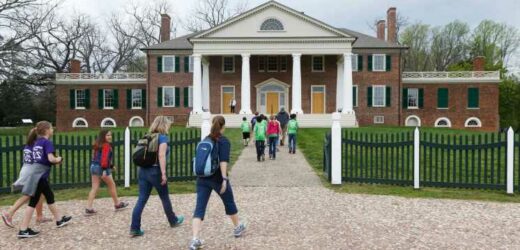ORANGE, Va. — In a breakthrough culminating nearly 30 years of work at James Madison’s Montpelier, descendants of enslaved persons at a major national historic site for the first time will be co-equals in governing the place that held their ancestors in bondage.
The National Trust for Historic Preservation, which owns the Virginia home of the fourth U.S. president and “Father of the Constitution,” lauded the decision by Montpelier’s board of directors.
Gene Hickok, board chair of of The Montpelier Foundation, said changing how the site is run caps “a 28-plus years engagement with the Montpelier descendants community, and more recently, a deliberate, year-long process by the board to achieve organizational and structural parity, which reflects the complete history of this specific place and America as a whole.”
►1619: How an accidental encounter brought slavery to the United States
►Slavery’s explosive growth: How ’20 and odd’ became millions
Hailed by Hickok as a historic decision, it is a first for U.S. museums and historic sites that are former places of enslavement, Montpelier said in a statement. James Madison is also considered the architect of the Bill of Rights. His most powerful idea: government by the people.
“Reckoning with the histories of racism”
On Wednesday, June 16, the foundation board of directors voted on a proposal from the descendants, to approve bylaws establishing the Montpelier Descendants Committee’s equality in governing James Madison’s Montpelier, a 2,650-acre estate in Orange County.
The vote “represents an important step toward equity and reckoning with histories of racism,” the foundation said. “The relationship provides a national model for resolving historic imbalances in decision-making, power and authority.”
“More than 300 American men, women and children were enslaved at Montpelier and played vital roles throughout the founding era of our country,” said James French, a Montpelier Foundation board member who is founding chair of the Montpelier Descendants Committee. “The true history of Montpelier cannot be known or shared without including the stories and perspectives of those who were enslaved.”
►The founding family you never heard of: The black Tuckers of Hampton, Virginia
Calling the vote groundbreaking, French said “the decision moves the perspectives of the descendants of the enslaved from the periphery to the center, and offers an important, innovative step for Montpelier to share broader, richer and more truthful interpretations of history with wider audiences.”
In a June 14 op-ed commentary in The Washington Post, French wrote, “Montpelier’s extraordinary power of place is remarkable in demonstrating how a single space was simultaneously occupied by polar opposite paradigms of power: freedom and slavery. What can we learn from this paradox? How should we interpret the history here, how should we tell it, and what lessons and impact can it have?”
Paul W. Edmondson, president of the National Trust for Historic Preservation, said the preservation group was pleased that the action provides the Montpelier Descendants Committee with equal representation on the foundation’s board.
“The Montpelier board of directors and the MDC have shown critical leadership in creating equitable governance of a site that is not only the ancestral home of James Madison, but also of hundreds of people enslaved by the Madison family,” Edmondson said. “The National Trust strongly supported this proposal, and we worked with both parties over the past year to achieve this new level of partnership. We commend both The Montpelier Foundation and the Montpelier Descendants Committee for working together to achieve this breakthrough.”
Structural parity at all levels
The vote on bylaws came during the week of Juneteenth, and followed a May 27 resolution saying the foundation board “affirms its commitment to collaborate with the Montpelier Descendants Committee to achieve structural parity with descendants at all levels of the organization.”
Montpelier President and CEO Roy Young praised the “difficult yet important work” by the board and committee.
“The May 27 resolution and bylaws vote were crucial steps forward and a substantive commitment to our partnership,” Young said. “… (W)e look forward to future conversations with MDC to find ways to increase our collaborations and contribute to our ‘Whole Truth History’ as a site of former enslavement, a Presidential Plantation, and the place the United States Constitution was conceived.”
MDC board member Patricia J. MacDaniel noted that the committee was founded during the week of Juneteenth in 2019. “Exactly two years later, the U.S. Senate and House of Representatives declared Juneteenth a federal holiday, signed into law … by President Joe Biden,” MacDaniel said. “We are proud to honor our ancestors with this momentous achievement.”
Selena Cozart and Frank Dukes, mediators with the University of Virginia’s Institute for Engagement & Negotiation, congratulated the board, the committee and the National Trust on their historic partnership. “We hope that the brave conversations that nurtured new relationships and that led to this truly momentous agreement will inspire other organizations to action,” Cozart and Dukes said.
In this April 12, 2017 photo, a school group walks up to the front entrance of James Madison's estate, Montpelier. At the time, crews were excavating and reconstructing six structures on the Virginia landmark's South Yard, where enslaved people lived and worked. (Photo: Steve Helber, AP)
Teaching enslaved people’s histories
Recently, the foundation and the committee applied for and were awarded state funding to lead a major project: To create a memorial to the enslaved and partner with other descendant groups to expand memorialization efforts throughout Virginia, establish educational programs for teachers and law enforcement officers, develop anti-racist curriculum available for use in Virginia’s public schools, and offer free public tours, community conversations, and other programs.
The two separate organizations work in collaboration, guided by principles agreed upon in February 2018, when Montpelier hosted the National Summit on Teaching Slavery. That rubric, titled “Best Practices in Descendant Engagement in the Interpretation of Slavery at Museums and Historic Sites,” is valuable for any historic site or museum where enslaved people played a historical role.
►Deep roots: Virginia woman believes her relatives were America’s first enslaved Africans
The summit, a partnership between Montpelier and the National Trust’s African American Cultural Heritage Action Fund, was the first national, interdisciplinary effort to formulate a model for engaging the descendants of people who were enslaved at nationally significant historic sites and museums.
The rubric sets standards to measure an organization’s “progress towards exemplary work in collaborative research, interpretation, and the overall relationship with a descendant community,” Montpelier said.
People enslaved at Montpelier
In 2019, Montpelier received a Museums for America Program award from the Institute of Museum and Library Services to design, build and install an interactive exhibition to foster conversations about fairness, justice and race between children and their caregivers.
That exhibit complements “The Mere Distinction of Colour,” an award-winning exhibition in James and Dolley Madison’s house that addresses the humanity and legacy of the hundreds of people the Madison family enslaved at their plantation. Opened in 2017, it explores what those individuals meant to our country and contextualizes ideas of the founding era.
The newest exhibit is located in a reconstructed circa-1790 spinning house-turned-slave quarter at Montpelier. An advisory group from Montpelier’s descendant community contributed to its design.
The Montpelier Descendants Committee strives to show how enslaved persons’ lives informed the notions of universal liberty enshrined in the Declaration of Independence and the U.S. Constitution that were denied to them. Not limited to Montpelier, the committee works to restore the narratives of enslaved Americans at plantation sites throughout Central Virginia. Learn more at montpelierdescendants.org.
To learn more about Montpelier, visit montpelier.org.
Source: Read Full Article



